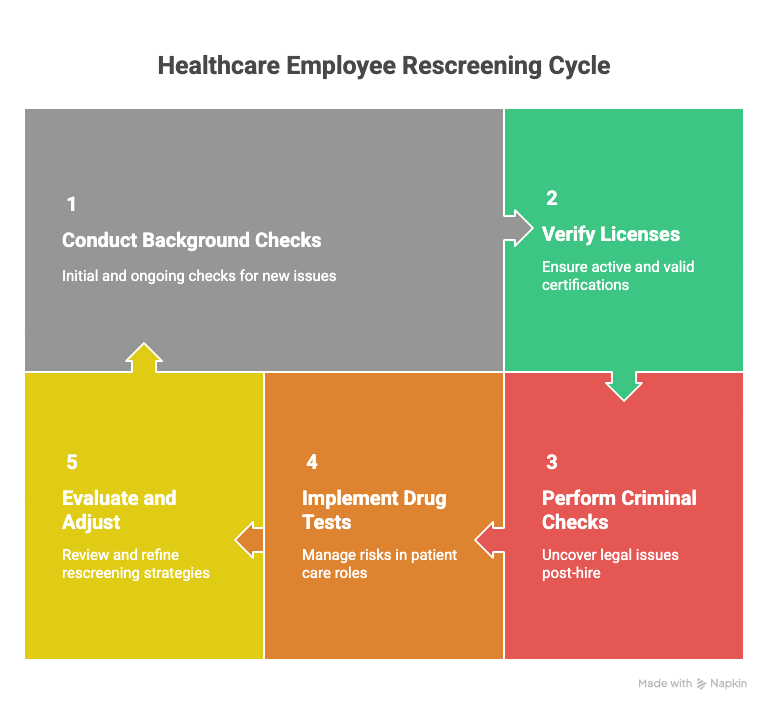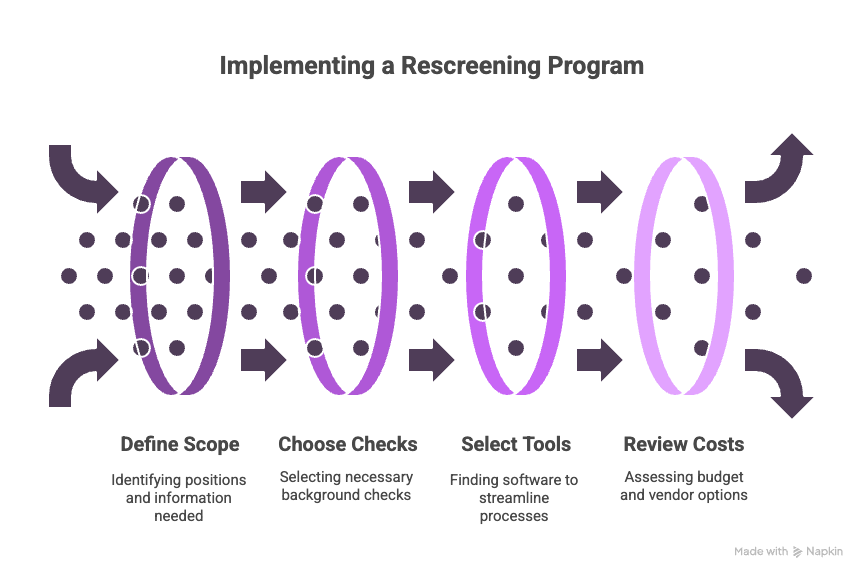In an industry where the stakes are incredibly high, maintaining rigorous standards for integrity and competency among healthcare professionals is non-negotiable. As a healthcare administrator or manager, you're likely familiar with the initial background checks performed during the hiring process. But what about once they're on board? Should you be conducting healthcare employee rescreening on an annual basis? There’s a growing conversation around this topic as the demand for transparency and compliance intensifies.
This guide delves into the necessity, processes, benefits, and challenges of re-screening healthcare staff annually. From understanding legal obligations to implementing effective rescreening strategies, we aim to provide a comprehensive view that will help you make informed decisions about continuous screening healthcare practices.
Key Takeaways
- Regular rescreening of healthcare staff is vital to catching new issues and ensuring the continued safety and trustworthiness of employees.
- Each rescreening should include key checks like criminal background, license verification, and drug testing, tailored to the needs of your facility.
- Implementing a clear rescreening policy and using effective tools can streamline the process and relieve your administrative burden.
- Balancing thorough checks with employee privacy rights and complying with legal standards are essential to a successful rescreening program.
- Learning from others, like Fairview Hospital and St. Agnes Clinic, demonstrates the tangible benefits and challenges of rescreening, ensuring your institution remains compliant and trusted.
Introduction
Did you know that a staggering 14% of healthcare workers have faced disciplinary action for issues related to conduct or performance (Leaver et al., 2019; National Practitioner Data Bank, 2023)? This figure underscores the importance of maintaining high standards in the healthcare sector, where the margin for error is virtually non-existent. As a manager or administrator, you’re aware of the rigorous initial checks new hires undergo. But what happens after they join your team? The question is whether ongoing, annual rescreening is necessary.
Healthcare employee rescreening refers to the continuous verification of staff credentials and backgrounds after their initial hire. This process is becoming increasingly relevant as scrutiny over healthcare practices intensifies. With the need for transparency never higher, understanding how and why to implement rescreening can be crucial.
This article aims to examine the practicality and benefits of re-screening medical employees every year. Should you allocate resources to ensure your staff remain compliant and trustworthy? We'll explore this topic to help you decide what's best for your organization.
EXPERT INSIGHT: By working extensively with health care teams, I have learned that recruitment is not a one-time process of initial hiring of an individual into the position; it is an ongoing requirement. These healthcare professionals are directly responsible for the well-being of patients, and it is our responsibility to make each practitioner competent, skilled, and of unimpeachable character. Annual re-assessment is not a distrust indicator; instead, it is a preventive strategy—advantageous to everyone: patients, staff, and the very nature of care. This is one of the subtle ways in which we demonstrate our commitment to safety in every area and examination room. It is a daily responsibility that I consider of great importance to help leaders create systems to uphold such trust. - Charm Paz, CHRP
The Basics of Healthcare Employee Rescreening
Rescreening healthcare employees involves conducting periodic background checks after the initial hiring process. It's more than a routine; it’s a crucial part of keeping the workplace compliant and safe. Why do it? Imagine you hire a nurse with a clean record. Over time, circumstances change. An annual rescreening helps catch any red flags early, like new criminal charges or disciplinary actions that might affect their ability to do their job.

There are a few key types of rescreening to consider. The most common is license verification to ensure medical professionals have active and valid certifications. Beyond this, ongoing criminal checks can uncover any legal issues that arise after the initial hire. These checks are vital for maintaining a safe environment for patients and staff alike.
Finally, rescreening programs can include drug tests, especially in roles involving patient care or access to medication. While it may seem like overkill to some, these measures are about risk management and upholding the integrity of your facility. When done right, rescreening supports a culture of safety and trust. How often should your facility perform these checks, and which types to include? These are questions worth considering as part of your overall human resource strategy.
The Importance of Continuous Screening in Healthcare
Staying current with compliance and regulations is crucial in healthcare. Laws and guidelines constantly evolve, requiring regular updates to stay compliant. This isn’t just about avoiding fines. It's about keeping your facility and patients safe. Continuous screening ensures you remain aligned with the latest standards.
Patient safety and trust are at the heart of healthcare. Patients expect secure and competent care. Ongoing background checks help reinforce public trust and confirm that employees continue to meet the necessary standards. Consider the peace of mind knowing every staff member retains the qualifications and clean record they started with.
Security in access-restricted areas is another critical aspect. Healthcare facilities house sensitive information and materials. Ensuring that only trustworthy individuals have access is paramount. Regular rescreening helps identify any changes that might affect an employee's suitability for access. Would you entrust just anyone with the keys to the pharmacy or patient records?
Keeping your team continuously vetted isn’t just a regulatory box to tick. It’s a proactive approach to building a safer, more compliant healthcare environment. Are you doing enough to ensure security and trust in your facility?
Implementing an Annual Rescreening Program
Creating a robust annual rescreening program begins with drafting a clear policy. As a healthcare administrator, it's your job to set guidelines that everyone can follow. Start with defining the scope. What positions need annual checks? What kind of information is necessary? Clearly outline expectations, responsibilities, and procedures.
Consider what types of checks to include. Criminal background checks, license verifications, and drug tests may be necessary depending on your healthcare facility and its needs. For example, a surgical unit might prioritize license verifications, while a rehab center might emphasize drug testing.
Choosing the right tools can simplify the process. Look for software that integrates with your existing human resources systems. Some programs offer automated reminders and updates, reducing administrative burdens. Check reviews and functionality to find a good fit for your facility's size and needs.
Review cost considerations carefully. The initial investment in software or hiring a background check service can seem significant. However, the benefits often outweigh these costs. For instance, maintaining a trustworthy team can prevent costly errors and foster a safe environment for patients, thereby offering a return on investment. Compare prices from different vendors and assess what aligns best with your budget.

Implementing a successful program requires commitment and planning. By following these steps, you can lay a solid foundation for effective rescreening that protects both your patients and your facility.
Challenges of Annual Rescreening
Annual rescreening in healthcare isn't without its challenges. Privacy tops the list. Employees often worry about how their personal information is managed. You must strike a balance between thorough checks and the privacy rights of your staff. Keep only what's necessary in secure, limited-access systems to ease these concerns.
Legal hurdles also come into play. Compliance with labor laws is non-negotiable. Know federal and state-specific requirements to avoid legal repercussions. Consult legal experts to ensure your policies fit within the legal framework. Regular training on current laws is advisable.
Resource allocation is another critical factor. Running an effective rescreening program demands time, money, and personnel. Consider the strain on your HR department. You may need additional staff or external services to manage the load efficiently. Weigh the cost against the benefits to find a sustainable balance.
Evaluating each aspect—from privacy to legal requirements and resource needs—requires time and effort. Yet, it's essential for the integrity of your rescreening program. Are you ready to meet these challenges head-on?
Case Studies and Examples
Let's start with Fairview Hospital, a mid-sized facility that implemented annual rescreening for all healthcare staff three years ago. The program involved regular criminal background checks, license verifications, and periodic drug testing. Management noticed a 20% decrease in compliance-related incidents. The hospital's leadership credits the rescreening program not only for this improvement but also for the increased trust among patients and their families.
At St. Agnes Clinic, they faced initial resistance when they rolled out their annual rescreening plan. Employees were worried about privacy, while administrators were concerned about costs. However, after conducting a cost-benefit analysis, they realized that the reduced risk of employing staff with outdated credentials more than justified the investment. By maintaining open communication and involving staff in policy development, St. Agnes managed to ease concerns and improved their compliance metrics.
On the other side, Mercy Medical Center faced hurdles with their rescreening approach. They initially applied a one-size-fits-all method, which didn’t account for the varying needs and roles within the organization. After consulting with experts, they shifted to a role-specific screening model, which prioritized high-sensitivity positions. This adjustment led to a smoother implementation and greater accuracy in identifying potential risks.
These examples highlight that while rescreening programs can pose challenges, they provide valuable insights into maintaining safety and compliance in healthcare settings. Each facility had to tailor their approach, learning lessons along the way. What steps will you take to ensure your healthcare institution stays ahead in this crucial area?
Conclusion
Re-screening healthcare staff annually is a strategic approach to maintain high standards in patient care and safety. It's not just about ticking a box; it's about ensuring your team remains compliant and trustworthy. The benefits extend beyond legal compliance, fostering a culture of accountability and reliability. By routinely updating background information, healthcare facilities can better manage risks and enhance patient trust. Now is the time to reassess your current screening methods. Consider annual rescreening as a meaningful investment in your institution's future stability and the community's well-being.
Frequently Asked Questions (FAQs)
Are hospitals required to run background checks annually?
Hospitals are not mandated by federal law to conduct annual background checks. However, some states or specific hospital policies may require them. It's essential to check with your local regulations or your hospital's policies.
What does re-screening a healthcare employee include?
Re-screening typically involves a review of criminal records, verification of professional licenses, checks against federal and state exclusion lists, and sometimes credit history. Each hospital may have different requirements.
Can employers check criminal records after hiring?
Yes, employers can check criminal records after hiring, especially if their policy includes continuous screening or re-screening at certain intervals. Clear policies in your workplace agreements will typically outline this ability.
What is continuous monitoring in healthcare hiring?
Continuous monitoring is an ongoing process that alerts employers to changes in an employee’s criminal record status. This helps ensure that all staff remain compliant with industry standards and regulations.
How do I set up an annual re-screening program?
Start by developing a clear policy that outlines the scope of the re-screening process. Coordinate with HR and legal experts to ensure compliance with state and federal laws. Choose a reliable background check provider to assist in the process and keep all necessary documentation.
Why is background screening crucial in healthcare?
Background checks help ensure patient safety by identifying individuals who may pose risks. It is a part of maintaining a trusted and reputable healthcare environment.
What areas are checked in healthcare background screening?
Common areas include criminal history, employment history, educational qualifications, professional licenses, and checks against exclusion lists from federal healthcare programs.
How often should healthcare employees be re-screened?
Frequency can vary based on state laws and employer policies. Some recommend annually, while others do so every few years. Evaluate your organization’s needs and legal requirements.
What are exclusion lists, and why are they checked?
Exclusion lists contain names of individuals and entities prohibited from participating in federal healthcare programs. Checking these lists helps maintain compliance and avoid legal repercussions.
Definitions
Rescreening
Rescreening is the practice of conducting background checks or credential verification on employees after they’ve been hired. In healthcare, this routine check is done annually or periodically to confirm that staff maintain valid licenses, have no new criminal charges, and meet job-specific requirements. Think of it as a second layer of trust and verification after the initial hiring process.
License Verification
License verification ensures healthcare workers hold valid, active professional licenses required for their roles. This process confirms that certifications haven’t expired, been suspended, or revoked. For roles like nurses, therapists, or physicians, this step helps confirm ongoing qualification to provide care.
Compliance
Compliance means meeting the legal, ethical, and regulatory standards that govern healthcare practices. It involves following federal and state labor laws, licensing rules, and safety guidelines. Staying compliant protects your facility from fines and helps create a trustworthy environment for patients and staff.
Background Check
A background check reviews records such as criminal history, employment history, and education. In healthcare, it often includes checking for prior misconduct, fraud, or abuse. Regular checks after hire help spot any new concerns that could affect patient safety or staff integrity.
Drug Testing
Drug testing checks for the presence of illegal or unauthorized substances in an employee’s system. In medical roles, this helps reduce the risks associated with impaired judgment or mishandling medications. Many facilities require random or annual tests to promote a safe workplace.
References
- https://fadv.com/blog/the-case-for-rescreening/
- https://www2.cisive.com/hubfs/Documents/White_Papers/Cisive_Insights_Talent_Screening_Trends_in_Healthcare_Benchmark_Report.pdf
- https://familymedicine.uw.edu/chws/wp-content/uploads/sites/5/2021/11/Background-Checks-FR-2021.pdf
- Leaver, C., Eckenwiler, L., & Peter, E. (2019). Disciplinary action trends among nurses in Canada: A longitudinal analysis. Journal of Nursing Regulation, 10(3), 24–31. https://www.journalofnursingregulation.com/article/S2155-8256(19)30145-0/fulltext
- National Practitioner Data Bank. (2023). 2023 Annual Report. U.S. Department of Health & Human Services. https://www.npdb.hrsa.gov/resources/reports/2023NPDBAnnualReport.pdf
Still have questions?
Get in touch with our team today for a personalized demo and discover how our tailored volume pricing and packages can drive results for your business!
How useful was this page?*
Note: your comments are anonymous. We use them to improve the website. Do not include any personal details.
Visit our FCRA Compliance Tool or leave a message here if you need a response.
From the blog Explore the GCheck Content Hub

DOT Physical Requirements for Drivers: 2026 Compliance Guide
9 Jan, 2026 • 17 min read
Healthcare Employee Background Check: What Employers Need to Know in 2026
9 Jan, 2026 • 19 min read
How Long Do Background Checks Take for Government Jobs? Timeline Expectations for 2026
6 Jan, 2026 • 20 min readThe information provided in this article is for general informational and educational purposes only and should not be construed as legal advice or a substitute for consultation with qualified legal counsel. While we strive to ensure accuracy, employment screening laws and regulations—including but not limited to the Fair Credit Reporting Act (FCRA), Equal Employment Opportunity Commission (EEOC) guidelines, state and local ban-the-box laws, industry-specific requirements, and other applicable federal, state, and local statutes—are subject to frequent changes, varying interpretations, and jurisdiction-specific applications that may affect their implementation in your organization. Employers and screening decision-makers are solely responsible for ensuring their background check policies, procedures, and practices comply with all applicable laws and regulations relevant to their specific industry, location, and circumstances. We strongly recommend consulting with qualified employment law attorneys and compliance professionals before making hiring, tenant screening, or other decisions based on background check information.


